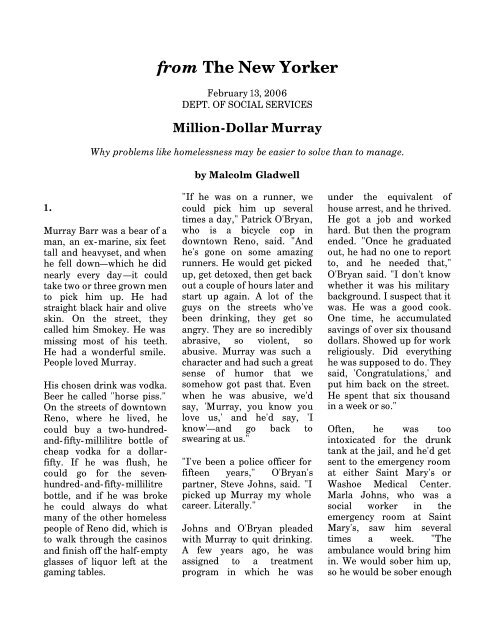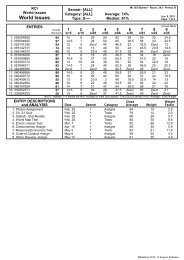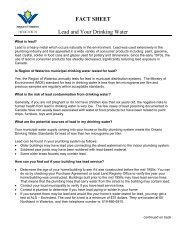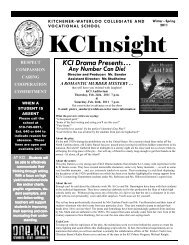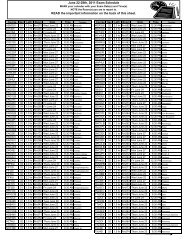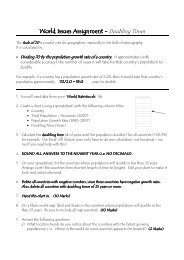Million Dollar Murray (article and questions combined).
Million Dollar Murray (article and questions combined).
Million Dollar Murray (article and questions combined).
Create successful ePaper yourself
Turn your PDF publications into a flip-book with our unique Google optimized e-Paper software.
1.<br />
from The New Yorker<br />
February 13, 2006<br />
DEPT. OF SOCIAL SERVICES<br />
<strong>Million</strong>-<strong>Dollar</strong> <strong>Murray</strong><br />
Why problems like homelessness may be easier to solve than to manage.<br />
<strong>Murray</strong> Barr was a bear of a<br />
man, an ex-marine, six feet<br />
tall <strong>and</strong> heavyset, <strong>and</strong> when<br />
he fell down—which he did<br />
nearly every day —it could<br />
take two or three grown men<br />
to pick him up. He had<br />
straight black hair <strong>and</strong> olive<br />
skin. On the street, they<br />
called him Smokey. He was<br />
missing most of his teeth.<br />
He had a wonderful smile.<br />
People loved <strong>Murray</strong>.<br />
His chosen drink was vodka.<br />
Beer he called "horse piss."<br />
On the streets of downtown<br />
Reno, where he lived, he<br />
could buy a two-hundred<strong>and</strong>-fifty-millilitre<br />
bottle of<br />
cheap vodka for a dollarfifty.<br />
If he was flush, he<br />
could go for the sevenhundred-<strong>and</strong>-fifty-millilitre<br />
bottle, <strong>and</strong> if he was broke<br />
he could always do what<br />
many of the other homeless<br />
people of Reno did, which is<br />
to walk through the casinos<br />
<strong>and</strong> finish off the half-empty<br />
glasses of liquor left at the<br />
gaming tables.<br />
by Malcolm Gladwell<br />
"If he was on a runner, we<br />
could pick him up several<br />
times a day," Patrick O'Bryan,<br />
who is a bicycle cop in<br />
downtown Reno, said. "And<br />
he's gone on some amazing<br />
runners. He would get picked<br />
up, get detoxed, then get back<br />
out a couple of hours later <strong>and</strong><br />
start up again. A lot of the<br />
guys on the streets who've<br />
been drinking, they get so<br />
angry. They are so incredibly<br />
abrasive, so violent, so<br />
abusive. <strong>Murray</strong> was such a<br />
character <strong>and</strong> had such a great<br />
sense of humor that we<br />
somehow got past that. Even<br />
when he was abusive, we'd<br />
say, '<strong>Murray</strong>, you know you<br />
love us,' <strong>and</strong> he'd say, 'I<br />
know'—<strong>and</strong> go back to<br />
swearing at us."<br />
"I've been a police officer for<br />
fifteen years," O'Bryan's<br />
partner, Steve Johns, said. "I<br />
picked up <strong>Murray</strong> my whole<br />
career. Literally."<br />
Johns <strong>and</strong> O'Bryan pleaded<br />
with <strong>Murray</strong> to quit drinking.<br />
A few years ago, he was<br />
assigned to a treatment<br />
program in which he was<br />
under the equivalent of<br />
house arrest, <strong>and</strong> he thrived.<br />
He got a job <strong>and</strong> worked<br />
hard. But then the program<br />
ended. "Once he graduated<br />
out, he had no one to report<br />
to, <strong>and</strong> he needed that,"<br />
O'Bryan said. "I don't know<br />
whether it was his military<br />
background. I suspect that it<br />
was. He was a good cook.<br />
One time, he accumulated<br />
savings of over six thous<strong>and</strong><br />
dollars. Showed up for work<br />
religiously. Did everything<br />
he was supposed to do. They<br />
said, 'Congratulations,' <strong>and</strong><br />
put him back on the street.<br />
He spent that six thous<strong>and</strong><br />
in a week or so."<br />
Often, he was too<br />
intoxicated for the drunk<br />
tank at the jail, <strong>and</strong> he'd get<br />
sent to the emergency room<br />
at either Saint Mary's or<br />
Washoe Medical Center.<br />
Marla Johns, who was a<br />
social worker in the<br />
emergency room at Saint<br />
Mary's, saw him several<br />
times a week. "The<br />
ambulance would bring him<br />
in. We would sober him up,<br />
so he would be sober enough
to go to jail. And we would<br />
call the police to pick him<br />
up. In fact, that's how I met<br />
my husb<strong>and</strong>." Marla Johns<br />
is married to Steve Johns.<br />
"He was like the one<br />
constant in an environment<br />
that was ever changing," she<br />
went on. "In he would come.<br />
He would grin that halftoothless<br />
grin. He called me<br />
'my angel.' I would walk in<br />
the room, <strong>and</strong> he would<br />
smile <strong>and</strong> say, 'Oh, my<br />
angel, I'm so happy to see<br />
you.' We would joke back<br />
<strong>and</strong> forth, <strong>and</strong> I would beg<br />
him to quit drinking <strong>and</strong> he<br />
would laugh it off. And when<br />
time went by <strong>and</strong> he didn't<br />
come in I would get worried<br />
<strong>and</strong> call the coroner's office.<br />
When he was sober, we<br />
would find out, oh, he's<br />
working someplace, <strong>and</strong> my<br />
husb<strong>and</strong> <strong>and</strong> I would go <strong>and</strong><br />
have dinner where he was<br />
working. When my husb<strong>and</strong><br />
<strong>and</strong> I were dating, <strong>and</strong> we<br />
were going to get married,<br />
he said, 'Can I come to the<br />
wedding?' And I almost felt<br />
like he should. My joke was<br />
'If you are sober you can<br />
come, because I can't afford<br />
your bar bill.' When we<br />
started a family, he would<br />
lay a h<strong>and</strong> on my pregnant<br />
belly <strong>and</strong> bless the child. He<br />
really was this kind of light."<br />
In the fall of 2003, the Reno<br />
Police Department started<br />
an initiative designed to<br />
limit panh<strong>and</strong>ling in the<br />
downtown core. There were<br />
<strong>article</strong>s in the newspapers,<br />
<strong>and</strong> the police department<br />
came under harsh criticism on<br />
local talk radio. The<br />
crackdown on panh<strong>and</strong>ling<br />
amounted to harassment, the<br />
critics said. The homeless<br />
weren't an imposition on the<br />
city; they were just trying to<br />
get by. "One morning, I'm<br />
listening to one of the talk<br />
shows, <strong>and</strong> they're just<br />
trashing the police<br />
department <strong>and</strong> going on<br />
about how unfair it is,"<br />
O'Bryan said. "And I thought,<br />
Wow, I've never seen any of<br />
these critics in one of the<br />
alleyways in the middle of the<br />
winter looking for bodies."<br />
O'Bryan was angry. In<br />
downtown Reno, food for the<br />
homeless was plentiful: there<br />
was a Gospel kitchen <strong>and</strong><br />
Catholic Services, <strong>and</strong> even<br />
the local McDonald's fed the<br />
hungry. The panh<strong>and</strong>ling was<br />
for liquor, <strong>and</strong> the liquor was<br />
anything but harmless. He<br />
<strong>and</strong> Johns spent at least half<br />
their time dealing with people<br />
like <strong>Murray</strong>; they were as<br />
much caseworkers as police<br />
officers. And they knew they<br />
weren't the only ones<br />
involved. When someone<br />
passed out on the street, there<br />
was a "One down" call to the<br />
paramedics. There were four<br />
people in an ambulance, <strong>and</strong><br />
the patient sometimes stayed<br />
at the hospital for days,<br />
because living on the streets<br />
in a state of almost constant<br />
intoxication was a reliable way<br />
of getting sick. None of that,<br />
surely, could be cheap.<br />
O'Bryan <strong>and</strong> Johns called<br />
someone they knew at an<br />
ambulance service <strong>and</strong> then<br />
contacted the local hospitals.<br />
"We came up with three<br />
names that were some of our<br />
chronic inebriates in the<br />
downtown area, that got<br />
arrested the most often,"<br />
O'Bryan said. "We tracked<br />
those three individuals<br />
through just one of our two<br />
hospitals. One of the guys<br />
had been in jail previously,<br />
so he'd only been on the<br />
streets for six months. In<br />
those six months, he had<br />
accumulated a bill of a<br />
hundred thous<strong>and</strong> dollars—<br />
<strong>and</strong> that's at the smaller of<br />
the two hospitals near<br />
downtown Reno. It's pretty<br />
reasonable to assume that<br />
the other hospital had an<br />
even larger bill. Another<br />
individual came from<br />
Portl<strong>and</strong> <strong>and</strong> had been in<br />
Reno for three months. In<br />
those three months, he had<br />
accumulated a bill for sixtyfive<br />
thous<strong>and</strong> dollars. The<br />
third individual actually had<br />
some periods of being sober,<br />
<strong>and</strong> had accumulated a bill<br />
of fifty thous<strong>and</strong>."<br />
The first of those people was<br />
<strong>Murray</strong> Barr, <strong>and</strong> Johns <strong>and</strong><br />
O'Bryan realized that if you<br />
totted up all his hospital<br />
bills for the ten years that he<br />
had been on the streets—as<br />
well as substance-abusetreatment<br />
costs, doctors'<br />
fees, <strong>and</strong> other expenses—<br />
<strong>Murray</strong> Barr probably ran<br />
up a medical bill as large as
anyone in the state of<br />
Nevada.<br />
"It cost us one million<br />
dollars not to do something<br />
about <strong>Murray</strong>," O'Bryan<br />
said.<br />
2.<br />
Fifteen years ago, after the<br />
Rodney King beating, the<br />
Los Angeles Police<br />
Department was in crisis. It<br />
was accused of racial<br />
insensitivity <strong>and</strong> ill<br />
discipline <strong>and</strong> violence, <strong>and</strong><br />
the assumption was that<br />
those problems had spread<br />
broadly throughout the rank<br />
<strong>and</strong> file. In the language of<br />
statisticians, it was thought<br />
that L.A.P.D.'s troubles had<br />
a "normal" distribution—<br />
that if you graphed them the<br />
result would look like a bell<br />
curve, with a small number<br />
of officers at one end of the<br />
curve, a small number at the<br />
other end, <strong>and</strong> the bulk of<br />
the problem situated in the<br />
middle. The bell-curve<br />
assumption has become so<br />
much a part of our mental<br />
architecture that we tend to<br />
use it to organize experience<br />
automatically.<br />
But when the L.A.P.D. was<br />
investigated by a special<br />
commission headed by<br />
Warren Christopher, a very<br />
different picture emerged.<br />
Between 1986 <strong>and</strong> 1990,<br />
allegations of excessive force<br />
or improper tactics were<br />
made against eighteen<br />
hundred of the eighty-five<br />
hundred officers in the<br />
L.A.P.D. The broad middle<br />
had scarcely been accused of<br />
anything. Furthermore, more<br />
than fourteen hundred<br />
officers had only one or two<br />
allegations made against<br />
them—<strong>and</strong> bear in mind that<br />
these were not proven<br />
charges, that they happened<br />
in a four-year period, <strong>and</strong> that<br />
allegations of excessive force<br />
are an inevitable feature of<br />
urban police work. (The<br />
N.Y.P.D. receives about three<br />
thous<strong>and</strong> such complaints a<br />
year.) A hundred <strong>and</strong> eightythree<br />
officers, however, had<br />
four or more complaints<br />
against them, forty-four<br />
officers had six or more<br />
complaints, sixteen had eight<br />
or more, <strong>and</strong> one had sixteen<br />
complaints. If you were to<br />
graph the troubles of the<br />
L.A.P.D., it wouldn't look like<br />
a bell curve. It would look<br />
more like a hockey stick. It<br />
would follow what<br />
statisticians call a "power law"<br />
distribution—where all the<br />
activity is not in the middle<br />
but at one extreme.<br />
The Christopher<br />
Commission's report<br />
repeatedly comes back to what<br />
it describes as the extreme<br />
concentration of problematic<br />
officers. One officer had been<br />
the subject of thirteen<br />
allegations of excessive use of<br />
force, five other complaints,<br />
twenty-eight "use of force<br />
reports" (that is, documented,<br />
internal accounts of<br />
inappropriate behavior), <strong>and</strong><br />
one shooting. Another had<br />
six excessive-force<br />
complaints, nineteen other<br />
complaints, ten use-of-force<br />
reports, <strong>and</strong> three shootings.<br />
A third had twenty-seven<br />
use-of-force reports, <strong>and</strong> a<br />
fourth had thirty-five.<br />
Another had a file full of<br />
complaints for doing things<br />
like "striking an arrestee on<br />
the back of the neck with the<br />
butt of a shotgun for no<br />
apparent reason while the<br />
arrestee was kneeling <strong>and</strong><br />
h<strong>and</strong>cuffed," beating up a<br />
thirteen-year-old juvenile,<br />
<strong>and</strong> throwing an arrestee<br />
from his chair <strong>and</strong> kicking<br />
him in the back <strong>and</strong> side of<br />
the head while he was<br />
h<strong>and</strong>cuffed <strong>and</strong> lying on his<br />
stomach.<br />
The report gives the strong<br />
impression that if you fired<br />
those forty-four cops the<br />
L.A.P.D. would suddenly<br />
become a pretty wellfunctioning<br />
police<br />
department. But the report<br />
also suggests that the<br />
problem is tougher than it<br />
seems, because those fortyfour<br />
bad cops were so bad<br />
that the institutional<br />
mechanisms in place to get<br />
rid of bad apples clearly<br />
weren't working. If you<br />
made the mistake of<br />
assuming that the<br />
department's troubles fell<br />
into a normal distribution,<br />
you'd propose solutions that<br />
would raise the performance<br />
of the middle—like better
training or better hiring—<br />
when the middle didn't need<br />
help. For those hard-core<br />
few who did need help,<br />
meanwhile, the medicine<br />
that helped the middle<br />
wouldn't be nearly strong<br />
enough.<br />
In the nineteen-eighties,<br />
when homelessness first<br />
surfaced as a national issue,<br />
the assumption was that the<br />
problem fit a normal<br />
distribution: that the vast<br />
majority of the homeless<br />
were in the same state of<br />
semi-permanent distress. It<br />
was an assumption that bred<br />
despair: if there were so<br />
many homeless, with so<br />
many problems, what could<br />
be done to help them? Then,<br />
fifteen years ago, a young<br />
Boston College graduate<br />
student named Dennis<br />
Culhane lived in a shelter in<br />
Philadelphia for seven weeks<br />
as part of the research for<br />
his dissertation. A few<br />
months later he went back,<br />
<strong>and</strong> was surprised to<br />
discover that he couldn't<br />
find any of the people he<br />
had recently spent so much<br />
time with. "It made me<br />
realize that most of these<br />
people were getting on with<br />
their own lives," he said.<br />
Culhane then put together a<br />
database—the first of its<br />
kind—to track who was<br />
coming in <strong>and</strong> out of the<br />
shelter system. What he<br />
discovered profoundly<br />
changed the way<br />
homelessness is understood.<br />
Homelessness doesn't have a<br />
normal distribution, it turned<br />
out. It has a power-law<br />
distribution. "We found that<br />
eighty per cent of the<br />
homeless were in <strong>and</strong> out<br />
really quickly," he said. "In<br />
Philadelphia, the most<br />
common length of time that<br />
someone is homeless is one<br />
day. And the second most<br />
common length is two days.<br />
And they never come back.<br />
Anyone who ever has to stay<br />
in a shelter involuntarily<br />
knows that all you think about<br />
is how to make sure you never<br />
come back."<br />
The next ten per cent were<br />
what Culhane calls episodic<br />
users. They would come for<br />
three weeks at a time, <strong>and</strong><br />
return periodically,<br />
particularly in the winter.<br />
They were quite young, <strong>and</strong><br />
they were often heavy drug<br />
users. It was the last ten per<br />
cent—the group at the farthest<br />
edge of the curve—that<br />
interested Culhane the most.<br />
They were the chronically<br />
homeless, who lived in the<br />
shelters, sometimes for years<br />
at a time. They were older.<br />
Many were mentally ill or<br />
physically disabled, <strong>and</strong> when<br />
we think about homelessness<br />
as a social problem—the<br />
people sleeping on the<br />
sidewalk, aggressively<br />
panh<strong>and</strong>ling, lying drunk in<br />
doorways, huddled on subway<br />
grates <strong>and</strong> under bridges—it's<br />
this group that we have in<br />
mind. In the early nineteen-<br />
nineties, Culhane's database<br />
suggested that New York<br />
City had a quarter of a<br />
million people who were<br />
homeless at some point in<br />
the previous half decade —<br />
which was a surprisingly<br />
high number. But only about<br />
twenty-five hundred were<br />
chronically homeless.<br />
It turns out, furthermore,<br />
that this group costs the<br />
health-care <strong>and</strong> socialservices<br />
systems far more<br />
than anyone had ever<br />
anticipated. Culhane<br />
estimates that in New York<br />
at least sixty-two million<br />
dollars was being spent<br />
annually to shelter just those<br />
twenty-five hundred hardcore<br />
homeless. "It costs<br />
twenty-four thous<strong>and</strong><br />
dollars a year for one of<br />
these shelter beds," Culhane<br />
said. "We're talking about a<br />
cot eighteen inches away<br />
from the next cot." Boston<br />
Health Care for the<br />
Homeless Program, a<br />
leading service group for the<br />
homeless in Boston, recently<br />
tracked the medical<br />
expenses of a hundred <strong>and</strong><br />
nineteen chronically<br />
homeless people. In the<br />
course of five years, thirtythree<br />
people died <strong>and</strong> seven<br />
more were sent to nursing<br />
homes, <strong>and</strong> the group still<br />
accounted for 18,834<br />
emergency-room visits—at a<br />
minimum cost of a thous<strong>and</strong><br />
dollars a visit. The<br />
University of California, San<br />
Diego Medical Center
followed fifteen chronically<br />
homeless inebriates <strong>and</strong><br />
found that over eighteen<br />
months those fifteen people<br />
were treated at the hospital's<br />
emergency room four<br />
hundred <strong>and</strong> seventeen<br />
times, <strong>and</strong> ran up bills that<br />
averaged a hundred<br />
thous<strong>and</strong> dollars each. One<br />
person—San Diego's<br />
counterpart to <strong>Murray</strong><br />
Barr—came to the<br />
emergency room eightyseven<br />
times.<br />
"If it's a medical admission,<br />
it's likely to be the guys with<br />
the really complex<br />
pneumonia," James<br />
Dunford, the city of San<br />
Diego's emergency medical<br />
director <strong>and</strong> the author of<br />
the observational study,<br />
said. "They are drunk <strong>and</strong><br />
they aspirate <strong>and</strong> get vomit<br />
in their lungs <strong>and</strong> develop a<br />
lung abscess, <strong>and</strong> they get<br />
hypothermia on top of that,<br />
because they're out in the<br />
rain. They end up in the<br />
intensive-care unit with<br />
these very complicated<br />
medical infections. These<br />
are the guys who typically<br />
get hit by cars <strong>and</strong> buses <strong>and</strong><br />
trucks. They often have a<br />
neurosurgical catastrophe as<br />
well. So they are very prone<br />
to just falling down <strong>and</strong><br />
cracking their head <strong>and</strong><br />
getting a subdural<br />
hematoma, which, if not<br />
drained, could kill them, <strong>and</strong><br />
it's the guy who falls down<br />
<strong>and</strong> hits his head who ends<br />
up costing you at least fifty<br />
thous<strong>and</strong> dollars. Meanwhile,<br />
they are going through<br />
alcoholic withdrawal <strong>and</strong> have<br />
devastating liver disease that<br />
only adds to their inability to<br />
fight infections. There is no<br />
end to the issues. We do this<br />
huge drill. We run up big lab<br />
fees, <strong>and</strong> the nurses want to<br />
quit, because they see the<br />
same guys come in over <strong>and</strong><br />
over, <strong>and</strong> all we're doing is<br />
making them capable of<br />
walking down the block."<br />
The homelessness problem is<br />
like the L.A.P.D.'s bad-cop<br />
problem. It's a matter of a few<br />
hard cases, <strong>and</strong> that's good<br />
news, because when a<br />
problem is that concentrated<br />
you can wrap your arms<br />
around it <strong>and</strong> think about<br />
solving it. The bad news is<br />
that those few hard cases are<br />
hard. They are falling-down<br />
drunks with liver disease <strong>and</strong><br />
complex infections <strong>and</strong><br />
mental illness. They need time<br />
<strong>and</strong> attention <strong>and</strong> lots of<br />
money. But enormous sums of<br />
money are already being spent<br />
on the chronically homeless,<br />
<strong>and</strong> Culhane saw that the kind<br />
of money it would take to<br />
solve the homeless problem<br />
could well be less than the<br />
kind of money it took to<br />
ignore it. <strong>Murray</strong> Barr used<br />
more health-care dollars, after<br />
all, than almost anyone in the<br />
state of Nevada. It would<br />
probably have been cheaper to<br />
give him a full-time nurse <strong>and</strong><br />
his own apartment.<br />
The leading exponent for the<br />
power-law theory of<br />
homelessness is Philip<br />
Mangano, who, since he was<br />
appointed by President Bush<br />
in 2002, has been the<br />
executive director of the U.S.<br />
Interagency Council on<br />
Homelessness, a group that<br />
oversees the programs of<br />
twenty federal agencies.<br />
Mangano is a slender man,<br />
with a mane of white hair<br />
<strong>and</strong> a magnetic presence,<br />
who got his start as an<br />
advocate for the homeless in<br />
Massachusetts. In the past<br />
two years, he has<br />
crisscrossed the United<br />
States, educating local<br />
mayors <strong>and</strong> city councils<br />
about the real shape of the<br />
homelessness curve. Simply<br />
running soup kitchens <strong>and</strong><br />
shelters, he argues, allows<br />
the chronically homeless to<br />
remain chronically<br />
homeless. You build a<br />
shelter <strong>and</strong> a soup kitchen if<br />
you think that homelessness<br />
is a problem with a broad<br />
<strong>and</strong> unmanageable middle.<br />
But if it's a problem at the<br />
fringe it can be solved. So<br />
far, Mangano has convinced<br />
more than two hundred<br />
cities to radically reëvaluate<br />
their policy for dealing with<br />
the homeless.<br />
"I was in St. Louis recently,"<br />
Mangano said, back in June,<br />
when he dropped by New<br />
York on his way to Boise,<br />
Idaho. "I spoke with people<br />
doing services there. They<br />
had a very difficult group of
people they couldn't reach<br />
no matter what they offered.<br />
So I said, Take some of your<br />
money <strong>and</strong> rent some<br />
apartments <strong>and</strong> go out to<br />
those people, <strong>and</strong> literally go<br />
out there with the key <strong>and</strong><br />
say to them, 'This is the key<br />
to an apartment. If you<br />
come with me right now I<br />
am going to give it to you,<br />
<strong>and</strong> you are going to have<br />
that apartment.' And so they<br />
did. And one by one those<br />
people were coming in. Our<br />
intent is to take homeless<br />
policy from the old idea of<br />
funding programs that serve<br />
homeless people endlessly<br />
<strong>and</strong> invest in results that<br />
actually end homelessness."<br />
Mangano is a history buff, a<br />
man who sometimes falls<br />
asleep listening to old<br />
Malcolm X speeches, <strong>and</strong><br />
who peppers his remarks<br />
with references to the civilrights<br />
movement <strong>and</strong> the<br />
Berlin Wall <strong>and</strong>, most of all,<br />
the fight against slavery. "I<br />
am an abolitionist," he says.<br />
"My office in Boston was<br />
opposite the monument to<br />
the 54th Regiment on the<br />
Boston Common, up the<br />
street from the Park Street<br />
Church, where William<br />
Lloyd Garrison called for<br />
immediate abolition, <strong>and</strong><br />
around the corner from<br />
where Frederick Douglass<br />
gave that famous speech at<br />
the Tremont Temple. It is<br />
very much ingrained in me<br />
that you do not manage a<br />
social wrong. You should be<br />
ending it."<br />
3.<br />
The old Y.M.C.A. in<br />
downtown Denver is on<br />
Sixteenth Street, just east of<br />
the central business district.<br />
The main building is a<br />
h<strong>and</strong>some six-story stone<br />
structure that was erected in<br />
1906, <strong>and</strong> next door is an<br />
annex that was added in the<br />
nineteen-fifties. On the<br />
ground floor there is a gym<br />
<strong>and</strong> exercise rooms. On the<br />
upper floors there are several<br />
hundred apartments—brightly<br />
painted one-bedrooms,<br />
efficiencies, <strong>and</strong> S.R.O.-style<br />
rooms with microwaves <strong>and</strong><br />
refrigerators <strong>and</strong> central<br />
airconditioning—<strong>and</strong> for the<br />
past several years those<br />
apartments have been owned<br />
<strong>and</strong> managed by the Colorado<br />
Coalition for the Homeless.<br />
Even by big-city st<strong>and</strong>ards,<br />
Denver has a serious<br />
homelessness problem. The<br />
winters are relatively mild,<br />
<strong>and</strong> the summers aren't nearly<br />
as hot as those of neighboring<br />
New Mexico or Utah, which<br />
has made the city a magnet for<br />
the indigent. By the city's<br />
estimates, it has roughly a<br />
thous<strong>and</strong> chronically<br />
homeless people, of whom<br />
three hundred spend their<br />
time downtown, along the<br />
central Sixteenth Street<br />
shopping corridor or in<br />
nearby Civic Center Park.<br />
Many of the merchants<br />
downtown worry that the<br />
presence of the homeless is<br />
scaring away customers. A<br />
few blocks north, near the<br />
hospital, a modest, lowslung<br />
detox center h<strong>and</strong>les<br />
twenty-eight thous<strong>and</strong><br />
admissions a year, many of<br />
them homeless people who<br />
have passed out on the<br />
streets, either from liquor<br />
or—as is increasingly the<br />
case—from mouthwash. "Dr.<br />
——Dr. Tich, they call it—is<br />
the br<strong>and</strong> of mouthwash<br />
they use," says Roxane<br />
White, the manager of the<br />
city's social services. "You<br />
can imagine what that does<br />
to your gut."<br />
Eighteen months ago, the<br />
city signed up with<br />
Mangano. With a mixture of<br />
federal <strong>and</strong> local funds, the<br />
C.C.H. inaugurated a new<br />
program that has so far<br />
enrolled a hundred <strong>and</strong> six<br />
people. It is aimed at the<br />
<strong>Murray</strong> Barrs of Denver, the<br />
people costing the system<br />
the most. C.C.H. went after<br />
the people who had been on<br />
the streets the longest, who<br />
had a criminal record, who<br />
had a problem with<br />
substance abuse or mental<br />
illness. "We have one<br />
individual in her early<br />
sixties, but looking at her<br />
you'd think she's eighty,"<br />
Rachel Post, the director of<br />
substance treatment at the<br />
C.C.H., said. (Post changed<br />
some details about her<br />
clients in order to protect<br />
their identity.) "She's a
chronic alcoholic. A typical<br />
day for her is she gets up<br />
<strong>and</strong> tries to find whatever 's<br />
going to drink that day. She<br />
falls down a lot. There's<br />
another person who came in<br />
during the first week. He<br />
was on methadone<br />
maintenance. He'd had<br />
psychiatric treatment. He<br />
was incarcerated for eleven<br />
years, <strong>and</strong> lived on the<br />
streets for three years after<br />
that, <strong>and</strong>, if that's not<br />
enough, he had a hole in his<br />
heart."<br />
The recruitment strategy<br />
was as simple as the one that<br />
Mangano had laid out in St.<br />
Louis: Would you like a free<br />
apartment? The enrollees<br />
got either an efficiency at the<br />
Y.M.C.A. or an apartment<br />
rented for them in a building<br />
somewhere else in the city,<br />
provided they agreed to<br />
work within the rules of the<br />
program. In the basement of<br />
the Y, where the racquetball<br />
courts used to be, the<br />
coalition built a comm<strong>and</strong><br />
center, staffed with ten<br />
caseworkers. Five days a<br />
week, between eight-thirty<br />
<strong>and</strong> ten in the morning, the<br />
caseworkers meet <strong>and</strong><br />
painstakingly review the<br />
status of everyone in the<br />
program. On the wall<br />
around the conference table<br />
are several large white<br />
boards, with lists of doctor's<br />
appointments <strong>and</strong> court<br />
dates <strong>and</strong> medication<br />
schedules. "We need a<br />
staffing ratio of one to ten to<br />
make it work," Post said. "You<br />
go out there <strong>and</strong> you find<br />
people <strong>and</strong> assess how 're<br />
doing in their residence.<br />
Sometimes we're in contact<br />
with someone every day.<br />
Ideally, we want to be in<br />
contact every couple of days.<br />
We've got about fifteen people<br />
we're really worried about<br />
now."<br />
The cost of services comes to<br />
about ten thous<strong>and</strong> dollars<br />
per homeless client per year.<br />
An efficiency apartment in<br />
Denver averages $376 a<br />
month, or just over forty-five<br />
hundred a year, which means<br />
that you can house <strong>and</strong> care<br />
for a chronically homeless<br />
person for at most fifteen<br />
thous<strong>and</strong> dollars, or about a<br />
third of what he or she would<br />
cost on the street. The idea is<br />
that once the people in the<br />
program get stabilized they<br />
will find jobs, <strong>and</strong> start to pick<br />
up more <strong>and</strong> more of their<br />
own rent, which would bring<br />
someone's annual cost to the<br />
program closer to six<br />
thous<strong>and</strong> dollars. As of today,<br />
seventy-five supportive<br />
housing slots have already<br />
been added, <strong>and</strong> the city's<br />
homeless plan calls for eight<br />
hundred more over the next<br />
ten years.<br />
The reality, of course, is<br />
hardly that neat <strong>and</strong> tidy. The<br />
idea that the very sickest <strong>and</strong><br />
most troubled of the homeless<br />
can be stabilized <strong>and</strong><br />
eventually employed is only a<br />
hope. Some of them plainly<br />
won't be able to get there:<br />
these are, after all, hard<br />
cases. "We've got one man,<br />
he's in his twenties," Post<br />
said. "Already, he has<br />
cirrhosis of the liver. One<br />
time he blew a blood alcohol<br />
of .49, which is enough to<br />
kill most people. The first<br />
place we had he brought<br />
over all his friends, <strong>and</strong> they<br />
partied <strong>and</strong> trashed the<br />
place <strong>and</strong> broke a window.<br />
Then we gave him another<br />
apartment, <strong>and</strong> he did the<br />
same thing."<br />
Post said that the man had<br />
been sober for several<br />
months. But he could<br />
relapse at some point <strong>and</strong><br />
perhaps trash another<br />
apartment, <strong>and</strong> they'd have<br />
to figure out what to do with<br />
him next. Post had just been<br />
on a conference call with<br />
some people in New York<br />
City who run a similar<br />
program, <strong>and</strong> they talked<br />
about whether giving clients<br />
so many chances simply<br />
encourages them to behave<br />
irresponsibly. For some<br />
people, it probably does. But<br />
what was the alternative? If<br />
this young man was put<br />
back on the streets, he<br />
would cost the system even<br />
more money. The current<br />
philosophy of welfare holds<br />
that government assistance<br />
should be temporary <strong>and</strong><br />
conditional, to avoid<br />
creating dependency. But<br />
someone who blows .49 on a<br />
Breathalyzer <strong>and</strong> has<br />
cirrhosis of the liver at the
age of twenty-seven doesn't<br />
respond to incentives <strong>and</strong><br />
sanctions in the usual way.<br />
"The most complicated<br />
people to work with are<br />
those who have been<br />
homeless for so long that<br />
going back to the streets just<br />
isn't scary to them," Post<br />
said. "The summer comes<br />
along <strong>and</strong> they say, 'I don't<br />
need to follow your rules.' "<br />
Power-law homelessness<br />
policy has to do the opposite<br />
of normal-distribution social<br />
policy. It should create<br />
dependency: you want<br />
people who have been<br />
outside the system to come<br />
inside <strong>and</strong> rebuild their lives<br />
under the supervision of<br />
those ten caseworkers in the<br />
basement of the Y.M.C.A.<br />
That is what is so perplexing<br />
about power-law homeless<br />
policy. From an economic<br />
perspective the approach<br />
makes perfect sense. But<br />
from a moral perspective it<br />
doesn't seem fair.<br />
Thous<strong>and</strong>s of people in the<br />
Denver area no doubt live<br />
day to day, work two or<br />
three jobs, <strong>and</strong> are<br />
eminently deserving of a<br />
helping h<strong>and</strong>—<strong>and</strong> no one<br />
offers them the key to a new<br />
apartment. Yet that's just<br />
what the guy screaming<br />
obscenities <strong>and</strong> swigging Dr.<br />
Tich gets. When the welfare<br />
mom's time on public<br />
assistance runs out, we cut<br />
her off. Yet when the<br />
homeless man trashes his<br />
apartment we give him<br />
another. Social benefits are<br />
supposed to have some kind<br />
of moral justification. We give<br />
them to widows <strong>and</strong> disabled<br />
veterans <strong>and</strong> poor mothers<br />
with small children. Giving<br />
the homeless guy passed out<br />
on the sidewalk an apartment<br />
has a different rationale. It's<br />
simply about efficiency.<br />
We also believe that the<br />
distribution of social benefits<br />
should not be arbitrary. We<br />
don't give only to some poor<br />
mothers, or to a r<strong>and</strong>om<br />
h<strong>and</strong>ful of disabled veterans.<br />
We give to everyone who<br />
meets a formal criterion, <strong>and</strong><br />
the moral credibility of<br />
government assistance<br />
derives, in part, from this<br />
universality. But the Denver<br />
homelessness program<br />
doesn't help every chronically<br />
homeless person in Denver.<br />
There is a waiting list of six<br />
hundred for the supportivehousing<br />
program; it will be<br />
years before all those people<br />
get apartments, <strong>and</strong> some<br />
may never get one. There isn't<br />
enough money to go around,<br />
<strong>and</strong> to try to help everyone a<br />
little bit—to observe the<br />
principle of universality—isn't<br />
as cost-effective as helping a<br />
few people a lot. Being fair, in<br />
this case, means providing<br />
shelters <strong>and</strong> soup kitchens,<br />
<strong>and</strong> shelters <strong>and</strong> soup<br />
kitchens don't solve the<br />
problem of homelessness. Our<br />
usual moral intuitions are<br />
little use, then, when it comes<br />
to a few hard cases. Power-law<br />
problems leave us with an<br />
unpleasant choice. We can<br />
be true to our principles or<br />
we can fix the problem. We<br />
cannot do both.<br />
4.<br />
A few miles northwest of the<br />
old Y.M.C.A. in downtown<br />
Denver, on the Speer<br />
Boulevard off-ramp from I-<br />
25, there is a big electronic<br />
sign by the side of the road,<br />
connected to a device that<br />
remotely measures the<br />
emissions of the vehicles<br />
driving past. When a car<br />
with properly functioning<br />
pollution-control equipment<br />
passes, the sign flashes<br />
"Good." When a car passes<br />
that is well over the<br />
acceptable limits, the sign<br />
flashes "Poor." If you st<strong>and</strong><br />
at the Speer Boulevard exit<br />
<strong>and</strong> watch the sign for any<br />
length of time, you'll find<br />
that virtually every car<br />
scores "Good." An Audi A4<br />
—"Good." A Buick Century—<br />
"Good." A Toyota Corolla—<br />
"Good." A Ford Taurus—<br />
"Good." A Saab 9-5—<br />
"Good," <strong>and</strong> on <strong>and</strong> on, until<br />
after twenty minutes or so,<br />
some beat-up old Ford<br />
Escort or tricked-out<br />
Porsche drives by <strong>and</strong> the<br />
sign flashes "Poor." The<br />
picture of the smog problem<br />
you get from watching the<br />
Speer Boulevard sign <strong>and</strong><br />
the picture of the<br />
homelessness problem you<br />
get from listening in on the<br />
morning staff meetings at<br />
the Y.M.C.A. are pretty
much the same. Auto<br />
emissions follow a powerlaw<br />
distribution, <strong>and</strong> the airpollution<br />
example offers<br />
another look at why we<br />
struggle so much with<br />
problems centered on a few<br />
hard cases.<br />
Most cars, especially new<br />
ones, are extraordinarily<br />
clean. A 2004 Subaru in<br />
good working order has an<br />
exhaust stream that's just<br />
.06 per cent carbon<br />
monoxide, which is<br />
negligible. But on almost<br />
any highway, for whatever<br />
reason—age, ill repair,<br />
deliberate tampering by the<br />
owner—a small number of<br />
cars can have carbonmonoxide<br />
levels in excess of<br />
ten per cent, which is almost<br />
two hundred times higher.<br />
In Denver, five per cent of<br />
the vehicles on the road<br />
produce fifty-five per cent of<br />
the automobile pollution.<br />
"Let's say a car is fifteen<br />
years old," Donald Stedman<br />
says. Stedman is a chemist<br />
<strong>and</strong> automobile-emissions<br />
specialist at the University<br />
of Denver. His laboratory<br />
put up the sign on Speer<br />
Avenue. "Obviously, the<br />
older a car is the more likely<br />
it is to become broken. It's<br />
the same as human beings.<br />
And by broken we mean any<br />
number of mechanical<br />
malfunctions—the<br />
computer's not working<br />
anymore, fuel injection is<br />
stuck open, the catalyst 's not<br />
unusual that these failure<br />
modes result in high<br />
emissions. We have at least<br />
one car in our database which<br />
was emitting seventy grams of<br />
hydrocarbon per mile, which<br />
means that you could almost<br />
drive a Honda Civic on the<br />
exhaust fumes from that car.<br />
It's not just old cars. It's new<br />
cars with high mileage, like<br />
taxis. One of the most<br />
successful <strong>and</strong> least publicized<br />
control measures was done by<br />
a district attorney in L.A. back<br />
in the nineties. He went to<br />
LAX <strong>and</strong> discovered that all of<br />
the Bell Cabs were gross<br />
emitters. One of those cabs<br />
emitted more than its own<br />
weight of pollution every<br />
year."<br />
In Stedman's view, the current<br />
system of smog checks makes<br />
little sense. A million<br />
motorists in Denver have to<br />
go to an emissions center<br />
every year—take time from<br />
work, wait in line, pay fifteen<br />
or twenty-five dollars—for a<br />
test that more than ninety per<br />
cent of them don't need. "Not<br />
everybody gets tested for<br />
breast cancer," Stedman says.<br />
"Not everybody takes an AIDS<br />
test." On-site smog checks,<br />
furthermore, do a pretty bad<br />
job of finding <strong>and</strong> fixing the<br />
few outliers. Car enthusiasts—<br />
with high-powered, highpolluting<br />
sports cars—have<br />
been known to drop a clean<br />
engine into their car on the<br />
day they get it tested. Others<br />
register their car in a faraway<br />
town without emissions<br />
testing or arrive at the test<br />
site "hot"—having just come<br />
off hard driving on the<br />
freeway —which is a good<br />
way to make a dirty engine<br />
appear to be clean. Still<br />
others r<strong>and</strong>omly pass the<br />
test when they shouldn't,<br />
because dirty engines are<br />
highly variable <strong>and</strong><br />
sometimes burn cleanly for<br />
short durations. There is<br />
little evidence, Stedman<br />
says, that the city's regime of<br />
inspections makes any<br />
difference in air quality.<br />
He proposes mobile testing<br />
instead. Twenty years ago,<br />
he invented a device the size<br />
of a suitcase that uses<br />
infrared light to instantly<br />
measure <strong>and</strong> then analyze<br />
the emissions of cars as they<br />
drive by on the highway. The<br />
Speer Avenue sign is<br />
attached to one of Stedman's<br />
devices. He says that cities<br />
should put half a dozen or so<br />
of his devices in vans, park<br />
them on freeway off-ramps<br />
around the city, <strong>and</strong> have a<br />
police car poised to pull over<br />
anyone who fails the test. A<br />
half-dozen vans could test<br />
thirty thous<strong>and</strong> cars a day.<br />
For the same twenty-five<br />
million dollars that Denver's<br />
motorists now spend on onsite<br />
testing, Stedman<br />
estimates, the city could<br />
identify <strong>and</strong> fix twenty-five<br />
thous<strong>and</strong> truly dirty vehicles<br />
every year, <strong>and</strong> within a few<br />
years cut automobile<br />
emissions in the Denver
metropolitan area by<br />
somewhere between thirtyfive<br />
<strong>and</strong> forty per cent. The<br />
city could stop managing its<br />
smog problem <strong>and</strong> start<br />
ending it.<br />
Why don't we all adopt the<br />
Stedman method? There's<br />
no moral impediment here.<br />
We're used to the police<br />
pulling people over for<br />
having a blown headlight or<br />
a broken side mirror, <strong>and</strong> it<br />
wouldn't be difficult to have<br />
them add pollution-control<br />
devices to their list. Yet it<br />
does run counter to an<br />
instinctive social preference<br />
for thinking of pollution as a<br />
problem to which we all<br />
contribute equally. We have<br />
developed institutions that<br />
move reassuringly quickly<br />
<strong>and</strong> forcefully on collective<br />
problems. Congress passes a<br />
law. The Environmental<br />
Protection Agency<br />
promulgates a regulation.<br />
The auto industry makes its<br />
cars a little cleaner, <strong>and</strong>—<br />
presto—the air gets better.<br />
But Stedman doesn't much<br />
care about what happens in<br />
Washington <strong>and</strong> Detroit.<br />
The challenge of controlling<br />
air pollution isn't so much<br />
about the laws as it is about<br />
compliance with them. It's a<br />
policing problem, rather<br />
than a policy problem, <strong>and</strong><br />
there is something<br />
ultimately unsatisfying<br />
about his proposed solution.<br />
He wants to end air<br />
pollution in Denver with a<br />
half-dozen vans outfitted<br />
with a contraption about the<br />
size of a suitcase. Can such a<br />
big problem have such a<br />
small-bore solution?<br />
That's what made the findings<br />
of the Christopher<br />
Commission so unsatisfying.<br />
We put together blue-ribbon<br />
panels when we're faced with<br />
problems that seem too large<br />
for the normal mechanisms of<br />
bureaucratic repair. We want<br />
sweeping reforms. But what<br />
was the commission's most<br />
memorable observation? It<br />
was the story of an officer with<br />
a known history of doing<br />
things like beating up<br />
h<strong>and</strong>cuffed suspects who<br />
nonetheless received a<br />
performance review from his<br />
superior stating that he<br />
"usually conducts himself in a<br />
manner that inspires respect<br />
for the law <strong>and</strong> instills public<br />
confidence." This is what you<br />
say about an officer when you<br />
haven't actually read his file,<br />
<strong>and</strong> the implication of the<br />
Christopher Commission's<br />
report was that the L.A.P.D.<br />
might help solve its problem<br />
simply by getting its police<br />
captains to read the files of<br />
their officers. The L.A.P.D.'s<br />
problem was a matter not of<br />
policy but of compliance. The<br />
department needed to adhere<br />
to the rules it already had in<br />
place, <strong>and</strong> that's not what a<br />
public hungry for institutional<br />
transformation wants to hear.<br />
Solving problems that have<br />
power-law distributions<br />
doesn't just violate our moral<br />
intuitions; it violates our<br />
political intuitions as well.<br />
It's hard not to conclude, in<br />
the end, that the reason we<br />
treated the homeless as one<br />
hopeless undifferentiated<br />
group for so long is not<br />
simply that we didn't know<br />
better. It's that we didn't<br />
want to know better. It was<br />
easier the old way.<br />
Power-law solutions have<br />
little appeal to the right,<br />
because they involve special<br />
treatment for people who do<br />
not deserve special<br />
treatment; <strong>and</strong> they have<br />
little appeal to the left,<br />
because their emphasis on<br />
efficiency over fairness<br />
suggests the cold numbercrunching<br />
of Chicago-school<br />
cost-benefit analysis. Even<br />
the promise of millions of<br />
dollars in savings or cleaner<br />
air or better police<br />
departments cannot entirely<br />
compensate for such<br />
discomfort. In Denver, John<br />
Hickenlooper, the city's<br />
enormously popular mayor,<br />
has worked on the<br />
homelessness issue tirelessly<br />
during the past couple of<br />
years. He spent more time<br />
on the subject in his annual<br />
State of the City address this<br />
past summer than on any<br />
other topic. He gave the<br />
speech, with deliberate<br />
symbolism, in the city's<br />
downtown Civic Center<br />
Park, where homeless<br />
people gather every day with<br />
their shopping carts <strong>and</strong><br />
garbage bags. He has gone<br />
on local talk radio on many
occasions to discuss what<br />
the city is doing about the<br />
issue. He has commissioned<br />
studies to show what a drain<br />
on the city's resources the<br />
homeless population has<br />
become. But, he says, "there<br />
are still people who stop me<br />
going into the supermarket<br />
<strong>and</strong> say, 'I can't believe<br />
you're going to help those<br />
homeless people, those<br />
bums.'"<br />
5.<br />
Early one morning a year<br />
ago, Marla Johns got a call<br />
from her husb<strong>and</strong>, Steve. He<br />
was at work. "He called <strong>and</strong><br />
woke me up," Johns<br />
remembers. "He was choked<br />
up <strong>and</strong> crying on the phone.<br />
And I thought that<br />
something had happened<br />
with another police officer. I<br />
said, 'Oh, my gosh, what<br />
happened?' He said, '<strong>Murray</strong><br />
died last night.' " He died of<br />
intestinal bleeding. At the<br />
police department that<br />
morning, some of the<br />
officers gave <strong>Murray</strong> a<br />
moment of silence.<br />
"There are not many days<br />
that go by that I don't have a<br />
thought of him," she went<br />
on. "Christmas comes— <strong>and</strong><br />
I used to buy him a<br />
Christmas present. Make<br />
sure he had warm gloves<br />
<strong>and</strong> a blanket <strong>and</strong> a coat.<br />
There was this mutual<br />
respect. There was a time<br />
when another intoxicated<br />
patient jumped off the<br />
gurney <strong>and</strong> was coming at me,<br />
<strong>and</strong> <strong>Murray</strong> jumped off his<br />
gurney <strong>and</strong> shook his fist <strong>and</strong><br />
said, 'Don't you touch my<br />
angel.' You know, when he<br />
was monitored by the system<br />
he did fabulously. He would<br />
be on house arrest <strong>and</strong> he<br />
would get a job <strong>and</strong> he would<br />
save money <strong>and</strong> go to work<br />
every day, <strong>and</strong> he wouldn't<br />
drink. He would do all the<br />
things he was supposed to do.<br />
There are some people who<br />
can be very successful<br />
members of society if<br />
someone monitors them.<br />
<strong>Murray</strong> needed someone to be<br />
in charge of him."<br />
But, of course, Reno didn't<br />
have a place where <strong>Murray</strong><br />
could be given the structure<br />
he needed. Someone must<br />
have decided that it cost too<br />
much.<br />
"I told my husb<strong>and</strong> that I<br />
would claim his body if no one<br />
else did," she said. "I would<br />
not have him in an unmarked<br />
grave."<br />
© 2006 Malcolm Gladwell
<strong>Million</strong> <strong>Dollar</strong> <strong>Murray</strong> – Article Questions<br />
1. Describe <strong>Murray</strong> Barr <strong>and</strong> the challenges he faced.<br />
2. How did treatment programs fail <strong>Murray</strong>?<br />
3. Describe the costs of keeping someone like <strong>Murray</strong> Barr on the street.<br />
4. What is the connection between racial insensitivity <strong>and</strong> homelessness? Describe.<br />
5. Why do “chronically homeless” (people who live in the shelters, sometimes for years at a time) cost<br />
the system so much money?<br />
6. Discuss the following: “the kind of money it would take to solve the homeless problem could well<br />
be less than the kind of money it took to ignore it.”<br />
7. What is the YMCA in Denver doing to combat homelessness? What type of people do they serve?<br />
8. What is the relationship between emission testing for vehicles <strong>and</strong> homelessness? Describe.<br />
9. How can some homeless people become “very productive members of society?”


